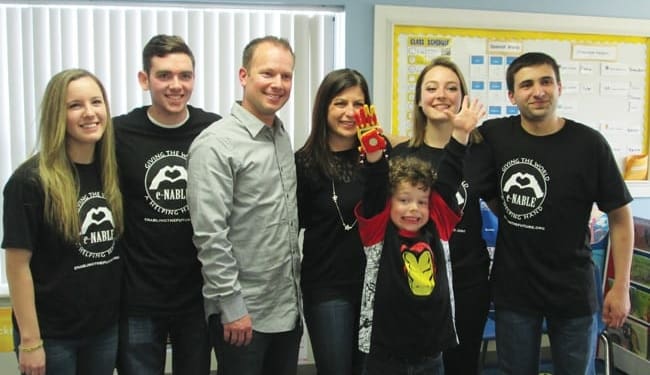Jack Carder, a 5-year-old Ohio boy, was born with only minimal use of a partially formed right hand, but a group of Siena College students have worked to change that. Through Siena’s chapter of Enabling the Future, e-Nable Siena, the group’s 13 students were matched with Jack to build him a customized 3D printed Iron Man-themed prosthetic hand that will allow him to pick up and grip objects more effectively. Four members of e-Nable Siena flew down to Columbus, Ohio last Tuesday, April 21, to deliver the prosthetic. The students have been working on Jack’s 3D printed hand for about three months after getting paired with the 5-year-old through Enabling the Future, a global program where volunteers use 3D printing technology to produce cost-effective prosthetic hands for people in need. Jack’s measurements were sent over to the Siena students, along with one other specification—an Iron Man theme. “That was (Jack’s) one request,” said Joey Fairley, a 2015 graduate and e-Nable Siena founder. “Because of the ability for the customization of these hands, we could have made it Superman theme, or anything, but he asked for Iron Man specifically.” The hand has the superhero’s iconic red and yellow colors, along with an LED light on the palm to look like Iron Man’s laser. Jack Rogers, e-Nable Siena member, said that, at first, the group was unsure if the light could go on the palm, since that is where prosthetic hands have Velcro to hold the prosthetic in place. The group considered glow-in-the-dark material, but decided to push for the light. “We looked online for circular lights. Luckily, we found one that fit the size specifications for the palm,” said Rogers. “Jack asked for the Iron Man design, so we didn’t want to let him down.” Enabling the Future volunteers work to design hands specifically for each individual. In Jack’s case, he has a working thumb on his right hand, but unusable fingers. The prosthetic has fingers, but space was made for Jack to continue using his own thumb. It is controlled by his wrist, so when he moves it, the fingers close. Fairley said the hand will give Jack a new range of motion and possibility. Before, Jack used his thumb to push things against the palm of his hand to pick objects up, said Fairley. Now, Jack can do more playful activities that five-year-olds typically enjoy. “He’s going to be able to pick something up off the table. He might be able to throw a ball around, too. Just little aspects he wouldn’t otherwise be able to do. He could grip a handlebar of a bike,” said Fairley. “This is going to give him a lot more degree of freedom with his fingers.” The hand was printed in individual parts, so pieces can withstand the play and roughness expected of a young child, said Fairley. As well, if pieces break, replacements can be printed, or even a whole new hand if needed, he said. There is also a strong possibility that e-Nable Siena will stay in contact with Jack as he continues to grow. “He’s only 5, so he’s going to continually need a bigger hand, and we’ve already done it once, so I don’t see why we couldn’t” print another prosthetic, said Rogers. Last Tuesday was the first time any of the students had met Jack in person, although Fairley said they spoke with Jack and his parents via video chat. Fairley, along with three other e-Nable Siena members, delivered the Iron Man prosthetic to Jack at his school before he threw the first pitch at a Columbus Clippers baseball game later that night. Fairley, a biomedical engineering major, said this experience has been humbling, and has confirmed for him the type of work he wants to go into. He said that technology like this will likely revolutionize how prosthetics are made within the next decade. “The ability of being able to just print something out when you want it is huge,” said Fairley. “We’re able to give (Jack) a fully customized hand to whatever specifications he wants. At the same time, they’re so practical and usable, especially for children, because he’s going to grow very, very quickly.”
Printing a helping hand
Leave Comment



